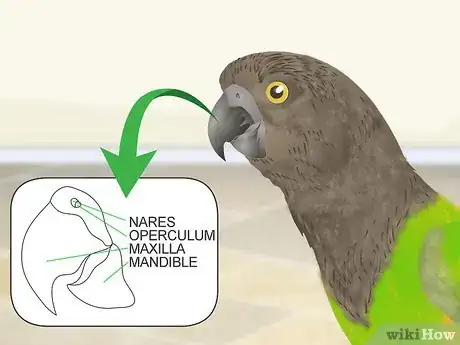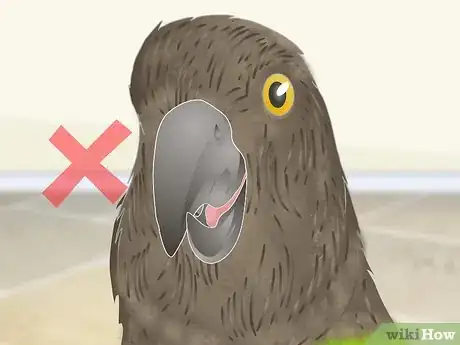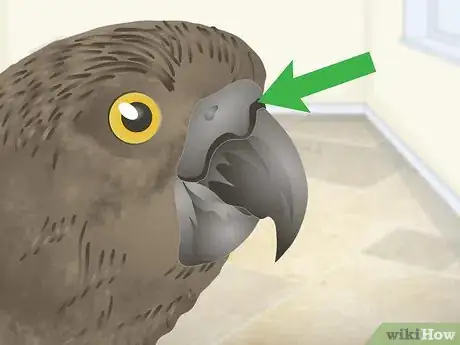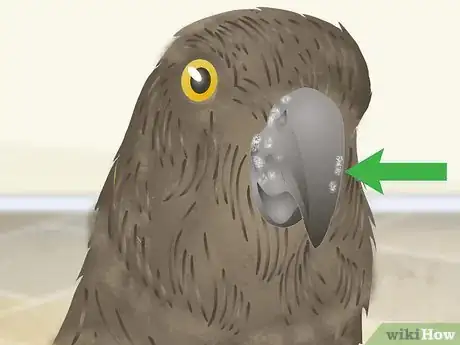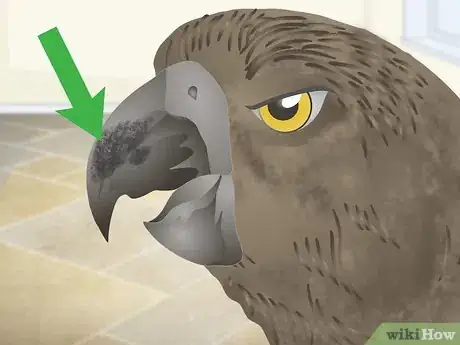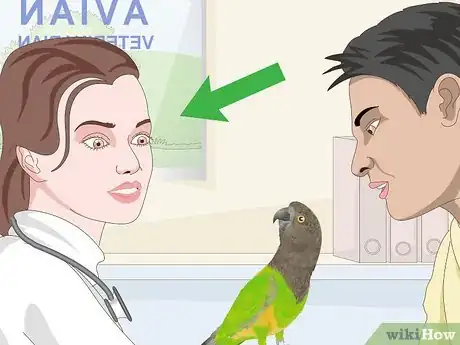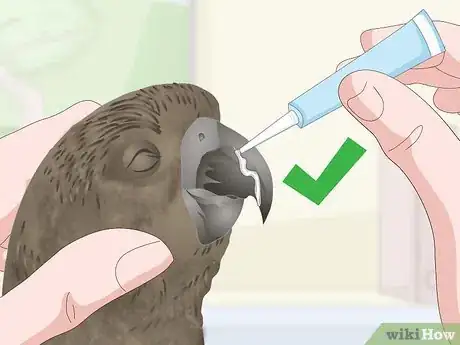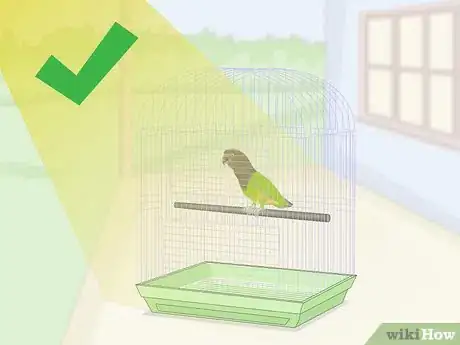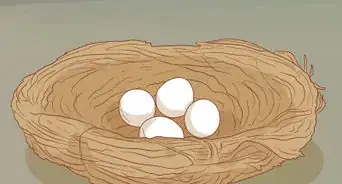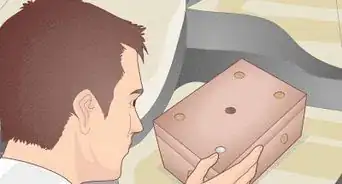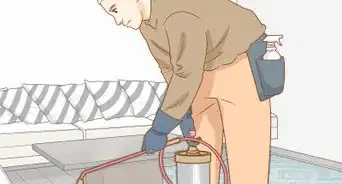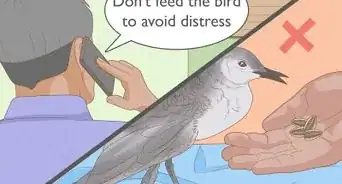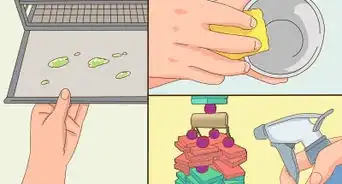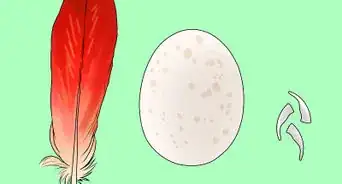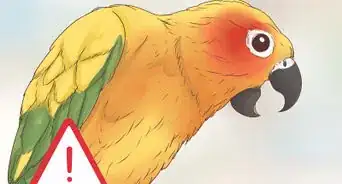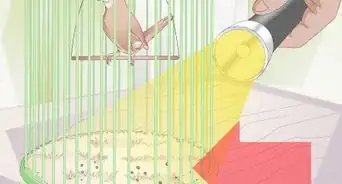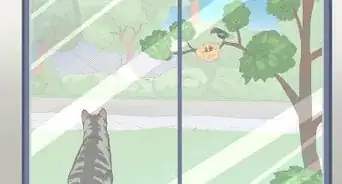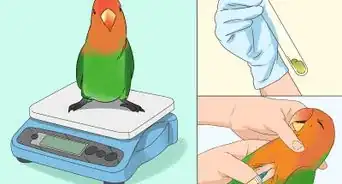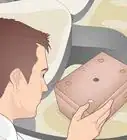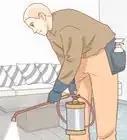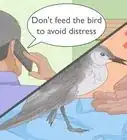This article was co-authored by Melissa Nelson, DVM, PhD. Dr. Nelson is a Veterinarian who specializes in Companion and Large Animal Medicine in Minnesota, where she has over 18 years of experience as a veterinarian in a rural clinic. She received her Doctor of Veterinary Medicine from the University of Minnesota in 1998.
There are 12 references cited in this article, which can be found at the bottom of the page.
This article has been viewed 19,329 times.
Senegal parrots sport dark green plumage with shiny black beaks. A parrot's beak is a beautiful and extremely sensitive nerve center. When you notice a problem, such as spotting or cracking, go ahead and reach out to your vet as soon as possible. If the beak is overgrown, a trim might help or even changing your bird's diet. Be patient and you'll likely see an improved beak in a month or so.[1]
Steps
Identifying a Beak Problem
-
1Familiarize yourself with beak anatomy. A parrot's beak has an upper jaw called the maxilla and a lower jaw called the mandible. A bird's nares (nostrils) are located at the top of his maxilla where his beak meets his head. Inside of the nares is something called the operculum, which is a small, round, and brown piece of tissue. This is normal, but some people may mistake it for an obstruction. Your parrot's entire beak is also covered in something called rhamphotheca, which is a keratin sheath similar to fingernails or antlers.[2]
- Having some familiarity with your parrot's beak anatomy may help you to identify when something is abnormal.
-
2Don't worry if your parrot sheds its old beak layers. Your bird's beak will continue to grow throughout its lifetime, just like a human's fingernails. It's normal for the outside layers to die and fall off over time, as the new inner ones develop. Dead tissue should flake away, not rot or appear powdery.[3]Advertisement
-
3Look for misalignment as a sign of abnormality. An overgrown beak occurs when either the upper or lower half significantly overhangs the other part. A scissor beak is when the upper and lower pieces do not align and one half hangs off to the side. [4]
- Sometimes beak conditions go hand-in-hand with other health problems. For example, a Senegal Parrot with Psittacine Beak and Feather Disease (PBFD) may have a cracked beak and abnormal, fragile feather growth.[5] If a parrot has an abnormal growth on his beak, then it may be a sign of liver disease or malnutrition. Or, if the beak becomes soft and pliable, then it could indicate that the parrot is suffering from a calcium or vitamin D deficiency.[6]
-
4Watch for thickening of the upper beak. This is when the base of the upper beak, known as the “cere,” begins to calcify and harden over time. It will start to outpace the growth of the other parts of the beak and may even look like a horned attachment. This condition is caused by brown hypertrophy and is problematic because it can limit beak mobility and eventually close up the nostrils. Vets will try to file down the area if it limits breathing.[7]
- Don't try to file down the beak yourself, as you could injure your bird in the process.
-
5Look for pitted and peeling spots on the beak. If your parrot's beak looks as if it has tiny dents all over it, then poor nutrition may be to blame. Low amino acid levels can break down the surface of the beak. Small pits and spots will appear, growing larger over time. Another cause could be aspergillosis which strikes Senegal parrots and requires a vet's care.[8]
- Your veterinarian will likely recommend improving your parrot's diet. To restore the amino acid balance for your bird, your veterinarian may recommend a diet rich in seeds, fish, and red meat.
-
6Look for tissue discoloration or bruising. If your bird has sustained an injury by flying into an object or fighting with another bird, then its beak might bruise or darken. These injuries usually resolve themselves over time, but it never hurts to get a vet check. Discoloration can also be caused by an infection and resulting inflammation. A blood test at the vet can usually narrow down the cause.[9]
Getting Professional Help
-
1Talk with your veterinarian. Hopefully you've already found a qualified avian vet, but, if not, now is the time to do so. Once you've noticed that your parrot's beak is abnormal in some way, you can point this out at a general check-up. Or, if your parrot is no longer eating or seems to be in any pain, you can make a specific appointment to discuss your bird's beak.[10]
- Your vet will give your parrot a general physical examination followed by a series of questioning regarding its health history and behavioral patterns. They may order additional testing, such as blood analyses, if necessary.
- It's best to act fast as beak problems can sometimes stem from a serious illness, such as cancer. Melanoma and squamous cell carcinoma can both develop on a Senegal parrot's beak.[11]
-
2Get your parrot tested for liver disease. When a parrot's liver function is impaired, they will often have an overgrown or softened beak. Overweight Senegal parrots, in particular, are prone to problems stemming from fatty liver disease. A simple blood test can check your bird's liver function. It's tough to heal the liver itself, so treatment usually involves boosting up amino acid levels in your bird's diet.[12]
-
3Get your parrot's beak professionally trimmed. Captive Senegal parrots, especially those without items for beak conditioning suck as a grooming perch, will need to get their beaks trimmed many times throughout a given year. It's best to go to your vet for this procedure, as a poorly trimmed beak can bleed and be quite painful for your bird. Anesthesia usually isn't necessary and the whole process takes just a few minutes.[13]
- Your vet will likely use a metal nail file, fingernail clipper, wire cutters, or a grinding stone to complete the trimming.
-
4Repair any large cracks or chips. You can expect an injured beak to bleed a great deal and to be very painful for your bird. For that reason, it's a good idea to head straight to your vet if your parrot has sustained a traumatic injury to its beak. Your vet will likely glue the beak together and place a bandage over the damaged area.[14]
- To stop or slow the bleeding, apply gentle pressure to the injured spot with a small clean cloth.
- Be aware that a cracked or torn beak will not grow together perfectly on its own. Your best bet to avoid long term damage is to seek out professional help.
- You can expect your bird to avoid eating for a few days after a beak injury, as it will likely still be sore.
Keeping Your Parrot's Beak Healthy
-
1Provide a nutritional supplement. Get a vitamin A powder that you can mix in with your parrot's water. Adding crushed vitamin B2 caplets into food or water can also help treat and prevent beak deformities. Talk with your vet about dosage, however, as too much vitamin A can cause many of the same problems as a deficiency.[15]
-
2Isolate any birds with infections. Viruses, such as PBFD, can quickly spread within your parrot population. As soon as you notice that one of your Senegal parrots is sick, place it in a separate cage in a room away from the others. Continue to keep any ill birds separate from the general population until the sick bird gets a clear bill of health from the vet.[16]
-
3Increase light exposure. Relocate your bird's cage, so that they get at least 8 hours of natural light throughout the day. Or, buy a full-spectrum light that you can put about 18 inches (46 cm) from the cage. Leave this light during daytime, but turn it off each night to give your parrot at least 12 hours of dark sleep. Ample light sources give your parrot vitamin D3, which helps to build a strong beak and fights kidney damage.[17]
- Set the light across the room from the cage and gradually move it closer over the course of a week. This will allow your parrot to get used to the change without being stressed.
- Be aware that certain shatter-resistant light bulbs are coated in Teflon, which give off fume that can be toxic to parrots.
-
4Provide additional mineral blocks and grooming aids. Senegal parrots are avid groomers and enjoy being able to chew their beaks down with natural wood toys. Lava rocks that hang from a chain also make great beak shapers. As the bird chews on the rock, the beak is polished and any overhang is rubbed away.[18]
- Replace any beak conditioners or toys when they are whittled down enough to present a choking hazard or if they get soiled with feces.
- Cuttlebones are a traditional toy staple for parrots, but there has been some concern about the mercury levels they contain.
Warnings
- When you hand feed your parrot, make sure to limit the amount of pressure that you use around the beak or you could gradually create deformities.⧼thumbs_response⧽
- If your bird is experiencing beak problems due to an illness, try to limits its contact with any immunocompromised persons to prevent the spread of germs.[19]⧼thumbs_response⧽
References
- ↑ https://lafeber.com/pet-birds/species/senegal-parrot/
- ↑ http://www.peteducation.com/article.cfm?c=15+1829&aid=2752
- ↑ https://www.beautyofbirds.com/beakdeformities.html
- ↑ http://www.drsfostersmith.com/pic/article.cfm?articleid=1390
- ↑ https://www.beautyofbirds.com/PBFD.html
- ↑ http://www.peteducation.com/article.cfm?c=15+1829&aid=2752
- ↑ https://www.beautyofbirds.com/beakdeformities.html
- ↑ https://www.beautyofbirds.com/beakdeformities.html
- ↑ https://www.beautyofbirds.com/beakdeformities.html
- ↑ https://www.beautyofbirds.com/beakdeformities.html
- ↑ http://www.birds.com/blog/a-closer-look-at-beak-problems/
- ↑ https://www.beautyofbirds.com/beakdeformities.html
- ↑ https://www.beautyofbirds.com/beakdeformities.html
- ↑ https://www.beautyofbirds.com/brokenbeaks.html
- ↑ https://petcentral.chewy.com/the-parrot-beak/
- ↑ http://www.petplace.com/article/birds/general/when-your-bird-is-sick/psittacine-beak-and-feather-disease
- ↑ https://www.beautyofbirds.com/lighting.html
- ↑ https://www.beautyofbirds.com/beakdeformities.html
- ↑ http://www.merckvetmanual.com/exotic-and-laboratory-animals/pet-birds/bacterial-diseases-of-pet-birds
About This Article
To tell if your Senegal parrot has a beak problem, check if one half of its beak overhangs the other part, which is a sign that something is wrong. Also, look for a thickening or calcifying upper beak, which can limit beak mobility and close up its nostrils. Additionally, look for small pits and peeling spots on its beak, which are often a symptom of poor nutrition. Also, look out for other discoloration or bruising of its beak, which may be a result of flying into an object or fighting with another bird. If you notice any abnormalities with your Senegal parrot’s beak, you should schedule an appointment with your vet. For more tips from our Veterinarian co-author, including how to keep your parrot’s beak healthy, read on!
